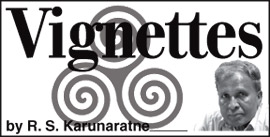The lure of loops and swirls
 Wherever
we see, we find children, adolescents and adults using block letters in
their writing. Teachers no longer insist on cursive writing which
requires students to use loops and swirls to form their letters. Most
students even do not know what to call rounded letters joined together. Wherever
we see, we find children, adolescents and adults using block letters in
their writing. Teachers no longer insist on cursive writing which
requires students to use loops and swirls to form their letters. Most
students even do not know what to call rounded letters joined together.
A few decades ago, parents used to give Royal Crown Copy Books to
their children to improve their handwriting. It was a pleasure to see
young children writing letters and words with 'G' nibs fitted to a pen
holder. As there was no flowing ink in such pens, the writer had to
insert the nib into a bottle of ink to wet it several times. It was a
cumbersome procedure to write with such a pen but the children enjoyed
it.
Today we no longer use 'G' nibs and pen holders. Gradually fountain
pens replaced the old writing instruments. There were many popular
brands of fountain pens such as "Swan", "Pilot" and "Dinky" and later
"Cial". They were relatively cheap and every student went to school
armed with a fountain pen. They no longer carried bottles of ink to
school.
Ballpoint pen
With the arrival of the ballpoint pen, the fountain pen bowed out.
Now students, teachers, executives and even ministers use ballpoint pens
as they are convenient and cheaper than fountain pens. However, some
Heads of State and company directors still prefer to use fountain pens
which are too expensive for ordinary people.
The revolution in writing instruments paved the way for the death of
penmanship. Today only a few students use Royal Crown Copy Books to
train themselves in cursive writing. A new generation of writers who
does not care to write beautiful curved letters has come into being.
They seem to believe that penmanship like hieroglyphics has lost its
glamour. However, should we erase cursive letters for good?
 |
|
Anne Frank's cursive
writing |
In the Digital Age writing has taken such a beating that in times to
come there won't be a single fountain pen in the market. Even the
ubiquitous ballpoint pen seems to have a short lifespan. Those who
belong to the new generation prefer to type, twitter, and email. They
send text messages using their mobile phones. The humble ballpoint pen
is still used to take down notes in classrooms and sign documents and
cheques.
Slanting strokes
What do we gain by allowing the written word to fade into oblivion?
Penmanship is more than pretty loops and slanting strokes. It's a way to
unravel our feelings, character traits and even our past. Graphologists
believe that handwriting even reveals our future. Although modern man
will scoff at the idea of penmanship, there are a lot of people who just
cannot stand to see handwriting die.
Some studies indicate that there is a link between cursive writing
and intelligence. Teachers who belong to the older generation will vouch
for the fact that students with good handwriting fared well in their
studies. On the other hand, those who do not believe in penmanship have
formulated all sorts of rationalisations. They say that there is no need
to bother about cursive writing because it is now a thing of the past.
They ask why we should waste time and energy in penmanship when we can
communicate effectively without it. According to them, there are many
eminent doctors, legal luminaries and authors whose writing is woefully
illegible. Even the great author Henry James used to dictate his novel
to his secretary without taking the trouble to write them.
Cursive writing can be a disincentive or even a phobia for modern day
students who are looking for ways to do things fast and furiously.
Penmanship is not for those who wish to reap quick results. Any child
would take a few years to develop his cursive writing. Many children
such as Trubeck who struggled with penmanship will begin to hate it for
no fault of theirs. Trubeck who later became a professor of English
says, "I understand that you need to know how to write, but I think
cursive could really just go."
Keyboarding
There are many modern teachers who support Prof. Trubeck's views.
They ask why should students worry about cursive writing because it has
been replaced by keyboarding. According to a recent study in the United
States, children do not spend even 15 minutes a day to practise cursive
writing. Even in Sri Lanka most of the students write block letters and
they have never heard of penmanship.
The gradual decline of penmanship sounds the death-knell of our
identity as individual writers. For instance, The Diary of Anne Frank
was written by the young author in cursive writing. The writing shows
the calibre of the writer. Although she was a child when the diary was
written, her handwriting shows her maturity and wisdom. By any chance,
if she had typed it, we would not have respected her so much.
Even Martin Wickramasinghe used cursive letters to write a string of
novels. His handwriting too shows the signs of a writer who had a deep
knowledge of many subjects. If there was no cursive writing, John
Hancock who wrote the original text of the Declaration of Independence
would be just another name on a legal document. Even the late Princess
Diana was known for her penmanship.
If we do not care to preserve cursive writing, another cultural icon
will vanish from human history.
|

